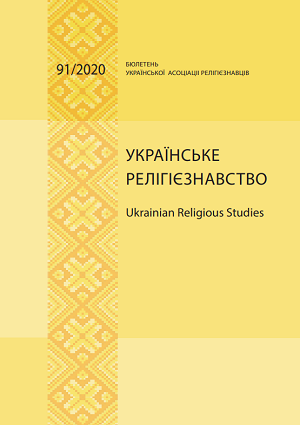The Syrian romance of St. Clement of Rome, and its early Slavonic version
DOI:
https://doi.org/10.32420/2020.91.2141Keywords:
Clement of Rome, pseudo-Clementines, Antioch, Ebionites, translationAbstract
The article analyzes the ethical and theological content of the apocryphal Syrian "autobiography" of St. Clement of Rome (Epytome), as well as its early Slavic translation (Life of St. Clement). The study uses historical-philosophical, patristic and philological methodology to outline the specific teachings, attributed to St. Clement by this Greek-speaking Syrian text from the pseudo-Clementine cycle. The methods of comparative textology and translation studies are used to analyze the features of the Slavic version of the work.
The study revealed that, contrary to the ideas of the publisher of the Slavic version, P. Lavrov, the translation was undoubtedly made according to the archaic, pre-metaphrasic version of the work. Therefore, it can be dated to the ninth century and come from the school of Cyril and Methodius. The popularity of the monument among Slavic readers is partly explained by the archaic features of the original version of the work preserved in the translation, such as graphic imagery, expressive presentation, and numerous dialogues. Such a lively account facilitated the perception of the conceptually rich ethical content of the work.
At the heart of both Greek and Slavic versions is the ethical category of philanthropy (φιλανθρωπία), which figures as a central Christian virtue. Much of the Epitome is devoted to a detailed explanation of this category and its distinction from other virtues. In the original, the ethics of philanthropy is opposed to the astrological ideology represented by Clement’s father Faust. Faust's views are based on the natural philosophical ideas of the early Greek Stoics. Apostle Peter, Clement's teacher, responds to his arguments from the standpoint of Judeo-Christian monotheism, referring to the biblical history of his people. Thus, Hellenism is confronted with biblical monotheism. So, Epitome appears a kind of argument in the controversy between Gentile Christians and Judeo-Christians (Ebionites), which has troubled the Syrian Church for centuries.
However, in translation, this clash of worldviews remains obscured, as the translator does not seem to recognize either the terminology of Stoic natural philosophy, or astrological issues, or the debate between the traditions of Peter and Paul in Syria. Thus, all the Stoic terminology of Faust is reduced to a single concept of "being". Therefore, in the translated version, the controversy is not so much between Christianity and astrology, as between ethics and "ontology". Instead, the translator enriches the philosophical outline of the work with polysemic Slavic vocabulary, which sheds new light on the role of the bishop in Peter’s instructions to Clement.
Comparison of the Greek and Slavic versions of the Epitome – an autobiography attributed to St. Clement – with his only authentic work, 1Corinthians, allowed to draw another unexpected conclusion. All these works are not only devoted to one main problem - the restoration of peace in the controversial Christian community, but also offer similar ways out of the crisis through brotherly love, solidarity and respect for the otherness of the fellow Christians. This may indicate either that the author of the Syrian apocrypha was inspired by the true Epistle of Clement to the Corinthians, or that the image of St. Clement, that developed in the early tradition, dictated the message of the pseudo-epigraph quite powerfully. Due to this consonance, the apocryphal work of the Syrian Ebionites did to some extent acquaint Slavic readers with the ideas of Clement of Rome, whose only authentic work was almost unknown in the Middle Ages.
References
Dressel A.R.M. (Ed.). (1859). Clementinorum epitomae duae. Leipzig: J.Heinrichs.
Dvornik F. (1962). The Slavs in European History and Civilization. Rutgers University Press.
Ellis F.S. (Ed.). (1900). Jacobus de Voragine. The Golden Legend or Lives of the Saints, 7 vols. London: Dent.
Floria B.N. (Ed.). (1981). Vita of St. Constantine, Legends on the Beginnings of Slavic Literature. Moscow: Nauka, p.70-93.
Franko I. (1981). St. Clement in Chersonese. Notes for the History of Ancient Christian Legend. In Ivan Franko.Collected works in 50 vols, vol.34 (pp. 7-347). Kyiv: Naukova dumka.
Jones F. S. (1982). The Pseudo-Clementines: A History of Research, Journal of Early Christian Studies, 2.1, p.14-33.
Khaburgaev G. (1994). First centuries of Slavic literature. Moscow State University Press.
Lavrov P.A. (Ed.) (1911). Literary monuments of Christian Khersones. vol.2. Lives of the Saints of Khersones in Greek and Slavonic Literature. Moscow: Lyssner Press.
Meshcherskiy N. (1995). Art of Translation in Kyivan Rus’. In Nikita Meshcherskiy. Selected works (pp. 246-271). Saint-Petersburg State University Press.
Paschke F. (1966). Die beiden griechischen Klementinen-Epitomen und ihre Anhänge. Berlin: Academie-Verlag.
Ukhanova Y.V. (2000). The acquisition of the relics of St. Clement, pope of Rome, in the context of the foreign and domestic policy of Byzantium in the middle of the 9th century. Byzantine Chronic, 59 (84), 116-128.
Ukhanova Y.V. (1998). Vigil to St. Clement, Pope of Rome, in the Context of Vladimir’s Baptizement of Rus. Proceedings of State Historical Museum, 100, 143-153.
Downloads
Published
Issue
Section
License
Copyright (c) 2020 Darya Morozova

This work is licensed under a Creative Commons Attribution-NonCommercial-ShareAlike 4.0 International License.


